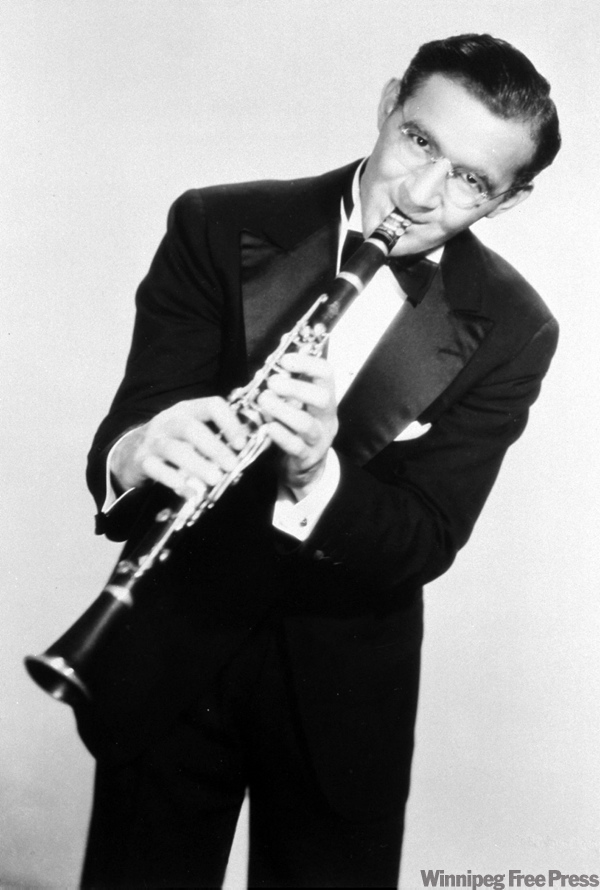‘King of Swing’ Benny Goodman would have turned 100 this month
Advertisement
Read this article for free:
or
Already have an account? Log in here »
To continue reading, please subscribe:
Monthly Digital Subscription
$1 per week for 24 weeks*
- Enjoy unlimited reading on winnipegfreepress.com
- Read the E-Edition, our digital replica newspaper
- Access News Break, our award-winning app
- Play interactive puzzles
*Billed as $4.00 plus GST every four weeks. After 24 weeks, price increases to the regular rate of $19.00 plus GST every four weeks. Offer available to new and qualified returning subscribers only. Cancel any time.
Monthly Digital Subscription
$4.75/week*
- Enjoy unlimited reading on winnipegfreepress.com
- Read the E-Edition, our digital replica newspaper
- Access News Break, our award-winning app
- Play interactive puzzles
*Billed as $19 plus GST every four weeks. Cancel any time.
To continue reading, please subscribe:
Add Winnipeg Free Press access to your Brandon Sun subscription for only
$1 for the first 4 weeks*
*$1 will be added to your next bill. After your 4 weeks access is complete your rate will increase by $0.00 a X percent off the regular rate.
Read unlimited articles for free today:
or
Already have an account? Log in here »
Hey there, time traveller!
This article was published 23/05/2009 (5951 days ago), so information in it may no longer be current.
FOR decades Benny Goodman and his clarinet popped up just about everywhere, and when they did, just about everyone knew it.
Goodman, who would have turned 100 on May 30, defined for most people the swing era that dominated popular American music for much of the 1930s and 1940s.
From Carnegie Hall and New York’s exclusive clubs to his backing up Jack Teagarden in 1933 on Texas Tea Party, he was as versatile and prolific as he was famous.

"Goodman had a style that can be identified before his name is announced," Ben Pollack, with whom Goodman first recorded in 1926, says in Nat Shapiro and Nat Hentoff’s 1955 classic book Hear Me Talkin’ To Ya.
Goodman sat in on the last recording session of hard-drinking, hellroaring and superbly talented blues singer Bessie Smith in 1934. A few days later he was there for the recording debut of promising young blues singer Billie Holliday. He even recorded with classic composer Bela Bartok.
Whether he was the greatest of his era is subjective, but he helped bring jazz out of smoky dives and into "respectable" (white) young America, to high school and college audiences and the American mainstream.
Goodman, who died of a heart attack in 1986 at age 77, relished the title King of Swing given him by the new white audiences who were largely unaware that black musicians, such as Louis Armstrong, were playing swing as far back as 1925.
"That some special thing, that style, that fluency he had lasted all the way through his career," says Gunther Schuller, a composer, conductor, and music historian whose books include The Swing Era.
The extent of Goodman’s staggering output is a guess. One 1969 discography, BG On The Record, runs to 600 pages and authors D. Russell Conner and Warren Hicks say they don’t have all of it. He recorded under numerous aliases with dozens of groups. Some was never released and is in private hands.
Before he formed his own band in 1934, Goodman did well with endless radio shows and dance records that fed an insatiable demand for something new.
Goodman was born to a large impoverished immigrant family in Chicago in 1909 as jazz was beginning to move up from the South.
He began studies very young, had his union card at age 13 and by 1923 was playing with the big names on Great Lakes excursion boats.
Goodman’s success was helped along mightily by piano player and arranger Fletcher Henderson, who had worked for Armstrong.
He delivered it big-time on Aug. 21, 1935, at the Palomar Ballroom in Los Angeles at the end of a tour that had gone poorly.
The crowd was uninspired, so the band switched to some of Henderson’s more lively arrangements.
People went crazy, Goodman shot to instant fame and many jazz historians consider that evening the beginning of the swing era.
Schuller calls Goodman’s playing flawless. Goodman expected no less, ever, from his sidemen and was not an easy man to work for. His turnover was high.
Vocalist Helen Ward quit citing his rudeness to her. Another, Helen Forrest, called him the rudest man she had ever met.
When Goodman returned with a band from a State Department-sponsored 1962 trip to the Soviet Union, someone asked saxophonist Zoot Simms what it was like playing in the Soviet Union.
"Every day with Goodman is like playing in the Soviet Union," he answered.
Goodman launched careers and led the dissolution of the taboo against black and white musicians playing together. He hired some of the best black talent around, including Lionel Hampton and Teddy Wilson. They, Goodman and drummer Gene Krupa made up the wildly popular Goodman Quartet beginning in the 1930s.
Some jazz writers say Artie Shaw may have been the better player. But in the public mind it is Goodman’s name that remains welded to swing.
— The Associated Press


